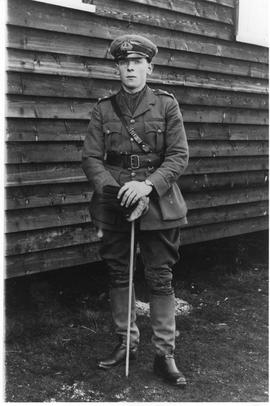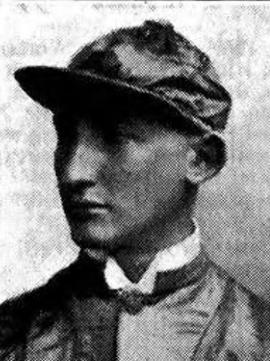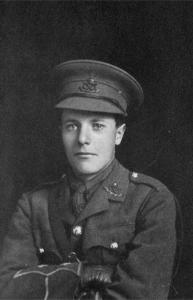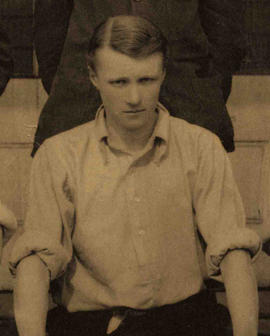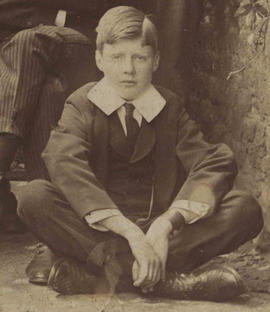Cooke, Guy Proudfoot, only son of David Frederick Cooke, of Teddington, Middlesex, solicitor, by Alice, widow of Arthur Proudfoot; b. Feb. 27, 1894; adm. from Uppingham School April 29, 1909 (A); left Dec. 1910; entered his father's office in Jan. 1911 and was articled to him in March 1913; joined the R. N. V. R. March 1913, and as a leading seaman took part in the operations at Antwerp in Oct. 1914; Sub-Lieut. R. N. V. R. (Nelson Batt.) Dec. 23, 1914; went out with the Mediterranean Expeditionary Force March 2, 1915; killed in action at Gaba Tepe, Gallipoli Peninsula, May 2nd, 1915; unm.
Coventry, Wyndham John, younger son of Frank Coventry, of Twickenham, by Louisa Emily, daughter of Sir John Joseph Grinlinton, of Middle Wallop, Hants; b. Dec. 25, 1886; adm. April 23, 1902 (A); left July 1904; R. M.C. Sandhurst 1906; 2nd Lieut. (unattached) Jan. 19, 1907, 44th Merwara Infantry (Indian Army) March 12, 1908; Squadron Officer 7th Hariana Lancers July 6, 1908; Lieut. Indian Army April 19, 1909; Capt. Sept. 1, 1915; left India with drafts for the 20th Deccan Horse Dec. 7, 1914, and served on the western front as observer in the Royal Flying Corps until. June 1915; was recalled to his regiment in India, and joined the expeditionary force to Mesopotamia July 1915; took part in the battles of Kut and Ctesiphon; mentioned in despatches; d. Jan. 1, 1916, of wounds received in action at Ali Gharh, Mesopotamia, the previous day; unm.
Cozens, Leslie, brother of Frederick Cyril Cozens (q.v.); b. Sept. 20, 1893; adm. April 30, 1908 (A); left July 1911; entered his father's business of tanner and currier at Walsall; 2nd Lieut. 5th Batt. South Staffs Regt. May 2, 1912; Lieut. March 1, 1914; Capt. May 19, 1915; went out to the western front March 3, 1915; d. Oct. 14, 1915, from wounds received in action at the Hohenzollern Redoubt the previous day; unm.
Cozens-Brooke, John Gilbert Somerset, only son of Ernest Brooke Cozens-Brooke, of Earl's Court, London, by Mabel Emily Florence, daughter of Capt. John William Clayton, of Marylebone; b. Nov. 26, 1893; adm. Jan. 16, 1908 (R); left July 1910; 2nd Lieut. 3rd Batt. (Spec. Res.) Royal Scots Fusiliers April 1, 1912; Lieut. Aug. 15, 1914, attached 1st Batt. on taking out draft from depot to the western front in Sept. 1914; killed whilst scouting near Lille Oct. 18, 1914.
Cracknell, Charles George Raphael, only son of Charles Collins, of Pimlico, by Annie Letitia, daughter of George Turner, of London; b. May 5, 1888; adm. Sept. 25, 1902 (G); assumed the surname of Cracknell in lieu of Collins by deed poll June 21, 1915, but was known by the name of Cracknell before leaving school; left Easter 1906; articled to a London firm of accountants; joined the H. A. C. on the outbreak of the war Aug. 4, 1914; went out to the western front with the 1st Batt. Sept. 17, 1914; 2nd Lieut. 24th (Co. of London) Batt. the London Regt. July 3, 1915; Lieut. Nov. 3, 1915; served in France 1914-7; joined the British Expeditionary Force to Palestine in Oct. 1917; d. at Tel-el-Brit. Dec. 29, 1917, of wounds received in the defence of Jerusalem, Dec. 27, 1917; unm.
Cragg-Hamilton, Derek, son of Sydney Charles Cragg-Hamilton and Edith, d. of Abel Simner of Friog, Merioneth; b. 3 Apr. 1909; adm. Sept. 1922 (A); left July 1927; adm. a solicitor Nov. 1932, practised in London; 2nd Lieut. 92 Bde RA (TA) Sept. 1927, Lieut. Sept. 1930, Capt. May 1934, temp. Maj. Jan. 1939; killed in action Dunkirk May 1940.
Derek Cragg-Hamilton was born at Ravenscourt Park, London on the 3rd of April 1909 the only son of Sydney Charles Cragg-Hamilton, an actor, and Edith Emily Marguerite (nee Simner) Cragg-Hamilton of 77, Hamlet Gardens, South Hammersmith, later of Newark-on-Trent in Nottinghamshire. He was christened at St Peter’s Church, Hammersmith on the 12th of June 1909. He was educated at Westminster School where he was up Ashburnham from September 1922 to July 1927 where he was a member of the Officer Training Corps and was promoted to Lance Corporal in 1926. He was appointed as a Monitor in April 1926 and as Head of Ashburnham in September 1926. On leaving school he studied law and he qualified as a solicitor in November 1932. He practised at Temple Chambers, Temple Avenue, London. He served as Hon. Secretary of The Old Westminster Boat Club in 1929 and 1930 and was a member of the Executive Committee of the Old Westminsters in 1932.
He was commissioned as a 2nd Lieutenant in 92 (5th London) Field Brigade in the Territorial Army on the 25th of September 1927 and was promoted to Lieutenant on the 25th of September 1930. He was promoted to Captain on the 10th of May 1934 and to Major in January 1939. He was appointed as the commanding officer of 365 Battery.
On the 31st of May 1940, 92 Field Regiment, Royal Artillery was positioned to the west of Bulskamp where it was defending the perimeter of the evacuation area around Dunkirk when German counter battery fire began falling on the Headquarters of 365 Battery. Derek Cragg-Hamilton and four gunners were killed during the exchange of fire.
The Middlesex Chronicle wrote: - “Many of the older residents will remember the cherry, happy personality of this fine, upstanding soldier who was 6ft 6 1/2 ins. in height.”
The Elizabethan wrote: - “The death of Major Derek Cragg-Hamilton, R.A., T.A., during the retirement to Dunkirk, has brought sadness to many, for he had many friends. In the law, which he chose as his profession, in the Territorials, which he joined as a recreation and a duty, and among Westminsters of all ages who shared with him a common affection for the School he was equally popular, and the directness and simplicity of his character won him general respect. Derek Cragg-Hamilton was the son of the late Sydney Charles Cragg-Hamilton. He was born on 3rd April, 1909, and in 1922 entered Westminster as a day boy up Ashburnham. Although his subsequent career showed that he had good critical abilities and the power of mastering detail, he travelled up the School but slowly. He was never one to whom success came easily. Success came because he worked for it, and it was a tribute to the solid qualities of his character when, in his last year at Westminster, he was appointed head of his house, although still only in the Shell. He left in 1927, and for the next five years underwent the arduous and sometimes dreary training necessary to become a solicitor. Most of his Westminster friends and contemporaries had gone to either Oxford or Cambridge, and he may perhaps have felt some natural regret that he was no longer with them, sharing their fresh interests and pleasures. If he did, he kept his feelings to himself and he threw himself wholeheartedly into his new work. At this time also began the connexion with the Territorials, which in the end took him to France early last September and last May to Belgium. He was gazetted 2nd Lieut., 92nd Brigade, R.A., T.A., in 1927, and was promoted Lieutenant in 1930. Captain in 1934, and Major last year. He was an enthusiastic soldier, and he was always keen to get any boys who had recently left the School into his battery, with the result that the foundress was toasted last November 17th in at least one mess in northern France. His ability as a lawyer received a tribute in a notice in The Times, and this is not the place to recapitulate it. While his Westminster friends realized that he was efficient at his job, they did not perhaps realize how much his judgment was respected and how much he might have achieved had not his career been suddenly cut short. But no one who came in contact with him could have remained unaware for long of his enthusiasm for the School and his devotion to its interests. His work on the War Memorial Committee and on successive Committees of the Westminster Ball brought him into touch with a very large number of Old Westminsters; and because some of the masters were privileged to count him as their friend, his views on the School did not remain static as the point which they had reached when he ceased to be a member of it, but moved forward with every phase of its development. He was, indeed, one of the very few people to whom one could "talk Westminster" with the complete assurance that his opinion would be based not only on sympathy and understanding, but also on knowledge of where the School's true interests lay. To Watermen of the last twelve years he was a familiar figure. Although never a first-class oar himself, he was an immensely hard worker in a boat and a good judge of a crew. He followed the fortunes of the School eight with keenness, and his appearances at Putney or at Henley were welcomed with delight. It was characteristic of him that when, a few years ago, he had followed a School eight down to Westminster in the launch and a minor crisis had occurred because one of the crew had been taken ill, he should have stepped into the boat and, although quite untrained, should have rowed back to Putney. It was characteristic, too, that when home on leave for a short time last December, one of his first actions should have been to come round to Westminster to find out how the School was getting on in exile, and in particular what chances there were of carrying on rowing at Lancing. In him Westminster loses a loyal friend, and his mother, to whom we offer our deep sympathy, a devoted son.”
He is buried at Veurne Communal Cemetery Extension Row C, Grave 5.
Craig, John McAdam, youngest son of James Craig, M. D., of Beckenham, Kent, by Mary, daughter of Richard Attenborough, of Sawtry, Hunts; b. May 11, 1886; adm. as (non-resident) Q.S. Sept. 27, 1900 (R); left July 1905; R. M.C. Sandhurst 1905; 2nd Lieut. Seaforth Highlanders Oct. 6, 1906; Lieut. (Indian Army) Jan. 6, 1909; Double Company Officer 57th (Wilde's) Rifles Sept. 21, 1909; served on the N. W. frontier of India 1908; attached to the 58th Rifles in the Indian division of the Expeditionary Force to the western front, which arrived at Marseilles Oct. 12, 1914; died Nov. 1, 1914, from wounds received in action near Bethune on the previous day; unm.
CROFT, SIR HERBERT ARCHER, BART., eldest son of Sir Herbert George Denman Croft, Bart., MP, and Georgiana Eliza Lucy, eldest dau. of Matthew Henry Marsh (qv); grandson of Sir Archer Denman Croft, Bart. (qv); b. 5 Sep 1868; adm. (R) 12 Apr 1882; left Dec 1884; went to Australia 1887, sheep-farming; succ. father as 10th baronet 11 Feb 1902; enlisted as private in Herefordshire Regt., Aug. 1914, and raised company of 150 men within a week; 2nd Lieut., 1st batt., Herefordshire Regt. 2 Sep 1914, Lieut.; Capt., 12 Sep 1914; went out with British expeditionary force to Mediterranean Jul 1915; DL Herefordshire, JP (1896), High Sheriff 1911; m. 1st, 20 Jun 1892 Kathleen, second dau. of John Hare, Invercargill, New Zealand; m. 2nd, 3 Feb 1903 Katharine Agnes, eldest dau. of Joseph Charlton Parr DL, Grappenhall Heyes, Cheshire; killed in action at Suvla Bay, Gallipoli 10 Aug 1915.
Crook, Philip John Lancaster, son of Edward Arnold Crook, glove manufacturer, of Gt Malvern, Worcs, and Mary Clare Broad, d. of Lieut.-Col. John Lancaster IMS; b. 29 May 1920; adm. May 1934 (B); left July 1938; Univ. of Birmingham; Roy. Tank Regt 1941-3 (Lieut.); killed in action (N. Africa) Apr. 1943.
Philip John Lancaster Crook was born at Streatham, London on the 29th of May 1920 the only son of Edward Arnold Crook, a glove manufacturer, and Mary Clare Broad (nee Lancaster) Crook, later of 5, Heathcroft, Hampstead, London NW11. He was the twin of his sister Elizabeth Lorna.
He was educated at Westminster School where he was up Busby’s from May 1934 to July 1938. He was a member of the Officer Training Corps and was promoted to Lance Corporal in September 1937. He was articled to a firm of solicitors before going on to the University of Birmingham from where he graduated LLb.
He attended an Officer Cadet Training Unit before being commissioned as a 2nd Lieutenant in the Royal Tank Regiment on the 8th of March 1941.
On the 1st of April 1943, Philip Crook was with A Squadron, 50th Royal Tank Regiment which was resting in camp at Djorf. During the day a party from the Squadron was organised to visit the scene of a battle in which they had been involved at the Mareth Line on the 22nd of March 1943 against the German 15th Panzer Division. They were to try to learn the lessons of the fighting there and to salvage equipment from the area. They had been warned that the area had been heavily booby trapped and mined by the Germans before they had retreated and were instructed to take extreme care. During the trip, for reasons which are not known, Philip Crook left the track which had been swept and found to be clear of mines. Following the explosion of a German “S” anti personnel mine he was found lying on the ground badly wounded by shrapnel. He was evacuated to an Advanced Dressing Station where he died of his wounds a few hours later.
He is commemorated on the war memorial at Malvern and on the memorial at the University of Birmingham.
He is buried at Sfax War Cemetery Plot X Row D, Grave 20.
Crowe, Hugh Barby, only son of Col. Percy Barby Crowe, of West Brompton, by Annie, daughter of William Henry Allen, of Bromham House, Beds, and sister of George Pemberton Allen (q.v.); b. April 18, 1894; adm. Sept. 26, 1907 (G); left Dec. 1911; Trin. Coll. Camb., matric. Michaelmas 1912; 2nd Lieut. 1st Batt. City of London Regt. (Royal Fusiliers) May 31, 1912; Lieut. Jan. 1, 1914; A.D.C. to Lord Lucan, commanding the 1st London Infantry Brigade; 2nd Lieut. 4th Batt. Royal Fusiliers Sept. 16, 1914, attached to the 5th Batt. at Dover, until he joined his own Batt. on the western front Nov. 31, 1914; Lieut. Feb. 11, 1915; invalided home from Ypres with concussion in April 1915; was transferred to the 2nd Batt. on his recovery, and went out to join the Mediterranean Expeditionary Force Aug. 14, 1915; drowned off the Gallipoli Peninsula in the collision between H. M. S. Hythe and H. M. S. Sarnia, while acting as Military Conducting Officer on the former vessel, Oct. 28, 1915; unm.
